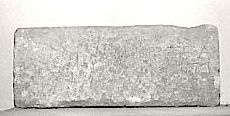EpiDoc XML:
IGCyr1262002
Trismegistos ID:
738811
Source description
Support: Rectangular block of white marble, with three dowel holes on the upper face, two in the rear edge and one in the right edge, showing that it was part of a larger monument extending to the right (w: 0.575 × h: 0.225 × d: 0.07-0.08); the back is smoothened in anathyrosis (wide 0.04).
Layout: Inscribed on the face probably in only two lines continuing on an adjacent block.
Letters: 0.03, small serifs; shorter central bar of epsilon, non-slanting sigma.The face is badly notched, which makes the reading very difficult.
Date: Perhaps second half of third of first half of first century BC (lettering).
Findspot: Found before 1979 at Cyrene ➚.
Place of origin: Findspot.
Last recorded location: Cyrene Museum, 174. Seen by C. Dobias-Lalou in 1979 and again in 1997 in Shahat: Cyrene Museum.
Text constituted from: Transcription from stone (CDL).
Bibliography
Not published before IGCyr 126200 ➚.
Text
French translation
[Untel] fils de Krateas. Kr[ateas fils de Dion?]ysios.
English translation
[So and so] son of Krateas. Kr[ateas son of Dion?]ysios.
Italian translation
[Un tale] figlio di Krateas. Kr[ateas figlio di Dion?]ysios.
Commentary
The poor condition of the face allows only hypothetical readings of what is clearly personal names. In the first edition, the restitutions were more cautious. However, a new examination of the squeeze shows a probable rho after kappa at the beginning of line 2, which seems to echo the name preserved at end of line 1. On behalf of the display, the latter is very plausibly the masculine Κρατέας, rather than the end of a feminine compound in -κράτεια, as proposed in IGCyr. Other short names in -έας do exist in Cyrenaica, such as Μνασέας and Ἀριστέας.
With the ending preserved at line 2, a very plausible restoration is [Διον]υσίω and the space available at left fits exactly Κρατέας. The two mentioned persons would have been father and son.
Although the space available at line 1 would fit exactly Διονύσιος, we prefer not to push this further, as anyhow we do not know at which case was the first name. The support and careful lettering indeed seem to belong to a monument which might have been made of several similar blocks. The names might be those of persons dedicating the monument, but there is no room on this block for a deitie's name. Alternatively, the names were those of persons honouring either each other (and the first name would be at the accusative) or honouring together another person mentioned in another part of the monument.
CC BY-NC-SA 4.0 Deed Attribution-NonCommercial-ShareAlike 4.0 International License.
All citation, reuse or distribution of this work must contain a link back to DOI: https://doi.org/10.60760/unibo/igcyrgvcyr2 and the filename (IGCyr000000 or GVCyr000), as well as the year of consultation.


